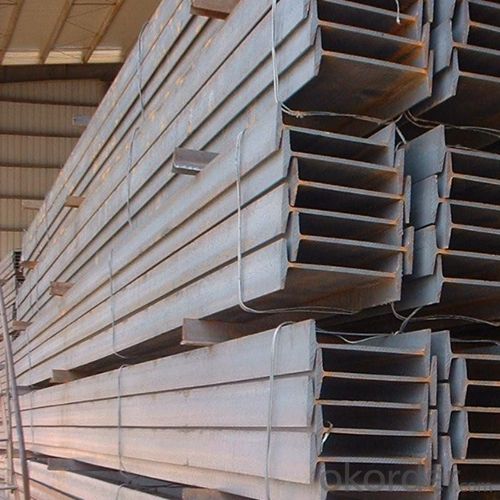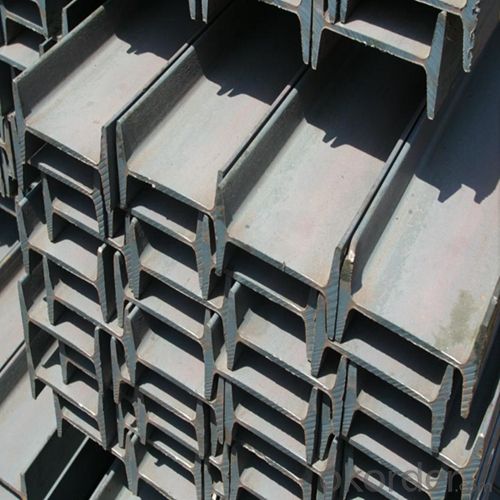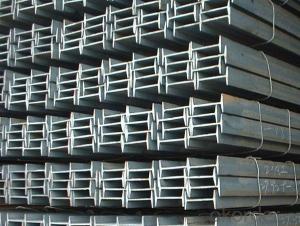Mild Steel Hot Rolled I Beam IPE In Construction Use
- Loading Port:
- China main port
- Payment Terms:
- TT or LC
- Min Order Qty:
- 25 m.t.
- Supply Capability:
- 10000 m.t./month
OKorder Service Pledge
OKorder Financial Service
You Might Also Like
Structure of Mild Steel Hot Rolled I Beam IPE In Construction Use Description:
Mild steel hot rolled I beam IPE in construction use is a beam with an I-shaped cross-section. The horizontal elements of the "I" are known as flanges, while the vertical element is termed the "web". Mild steel hot rolled I beam IPE in construction use is usually made of structural steel and is used in construction and civil engineering. The mild steel hot rolled I beam IPE in construction use resists shear forces, while the flanges resist most of the bending moment experienced by the beam. Mild steel hot rolled I beam IPE in construction use theory shows that the I-shaped section is a very efficient form for carrying both bending and shears loads in the plane of the web.
2. Main Features of Mild Steel Hot Rolled I Beam IPE In Construction Use:
• Grade: Q235
• Type: Mild carbon steel
• Deflection: The stiffness of the I-beam will be chosen to minimize deformation
• Vibration: The stiffness and mass are chosen to prevent unacceptable vibrations, particularly in settings sensitive to vibrations, such as offices and libraries.
• Local yield: Caused by concentrated loads, such as at the beam's point of support.
3. Mild Steel Hot Rolled I Beam IPE In Construction Use Images:



4. Mild Steel Hot Rolled I Beam IPE In Construction Use Specification:
Mechanical Properties | Grade | Steel diameter(mm) | |||
≤16 | 16~40 | 40~60 | 60~100 | ||
Yield Point Δs/MPa | Q195 | ≥195 | ≥185 | - | - |
Q235 | 235 | 225 | 215 | 205 | |
Tensile Strength | Q195 | 315~390 | |||
Q235 | 375~500 | ||||
Elongation δ5% | Q195 | ≥33 | ≥32 | - | - |
Q235 | 26 | 25 | 24 | 23 | |
5. FAQ
We have organized several common questions for our clients,may help you sincerely:
①Is this product same as W beam?
In the United States, the most commonly mentioned I-beam is the wide-flange (W) shape. These beams have flanges in which the planes are nearly parallel. Other I-beams include American Standard (designated S) shapes, in which flange surfaces are not parallel, and H-piles (designated HP), which are typically used as pile foundations. Wide-flange shapes are available in grade ASTM A992,[4] which has generally replaced the older ASTM grades A572 and A36.
②How to inspect the quality?
We have a professional inspection group which belongs to our company. We resolutely put an end to unqualified products flowing into the market. At the same time, we will provide necessary follow-up service assurance.
③Is there any advantage about this kind of product?
Steel I beam bar IPE has a reduced capacity in the transverse direction, and is also inefficient in carrying torsion, for which hollow structural sections are often preferred.
- Q:Can steel I-beams be used in mezzanine or elevated platform construction?
- Yes, steel I-beams can be used in mezzanine or elevated platform construction. Steel I-beams are commonly used in construction due to their strength and structural integrity. They provide excellent support and stability for mezzanine and elevated platform structures. Steel I-beams can be designed and installed to meet the specific load requirements and architectural design of the project. They are versatile and can be used in a variety of construction applications, including mezzanines and elevated platforms.
- Q:What are the common types of connections for steel I-beams in moment-resisting frames?
- Steel I-beams in moment-resisting frames can be connected using bolted connections, welded connections, or hybrid connections. Bolted connections involve using bolts and nuts to join the I-beams to other structural components like columns and beams. These connections offer flexibility, easy installation, and disassembly if needed. They also allow for adjustments during construction or future modifications. Welded connections, on the other hand, permanently join the I-beams to other components using welding techniques. This type of connection provides high strength and rigidity, ensuring a robust and stable frame. Welded connections are commonly used in moment-resisting frames because they can transfer large forces and moments between structural members. Hybrid connections combine both bolted and welded connections. Typically, bolts are used for the primary connection, and welding is used for additional reinforcement. Hybrid connections offer the advantages of both bolted and welded connections, such as ease of installation and high strength. The choice of connection type depends on various factors, including design requirements, load capacity, construction methods, and cost considerations. Structural engineers carefully analyze these factors to determine the most suitable connection type for steel I-beams in moment-resisting frames, ensuring overall stability and performance of the structure.
- Q:Are steel I-beams suitable for long-span bridges?
- Yes, steel I-beams are suitable for long-span bridges. They have high strength-to-weight ratio and can efficiently carry heavy loads over long distances, making them a popular choice for constructing long-span bridges.
- Q:Are there any design considerations for incorporating steel I-beams in sustainable bridges?
- Yes, there are several design considerations for incorporating steel I-beams in sustainable bridges. Firstly, the selection of steel for the I-beams should take into account its environmental impact. Using recycled or repurposed steel can significantly reduce the carbon footprint of the bridge. Additionally, the design should aim to minimize the amount of steel used while still maintaining structural integrity. To enhance sustainability, the bridge should be designed to have a long service life. This can be achieved by incorporating corrosion-resistant coatings on the steel I-beams, which will protect them from environmental factors and extend their lifespan. Regular inspections and maintenance should also be implemented to identify and address any potential issues before they become major problems. Furthermore, the design should consider the overall aesthetics and integration of the bridge into its surroundings. By incorporating natural materials, such as wood or vegetation, the bridge can blend harmoniously with the environment and enhance the visual appeal. Additionally, the design should consider the impact on local ecosystems, such as preserving aquatic habitats or creating wildlife passages. Another important consideration is the construction process itself. Utilizing sustainable construction practices, such as minimizing energy consumption, reducing waste, and using eco-friendly materials, can further enhance the sustainability of the bridge. Additionally, the design should consider the ease of disassembly and recyclability of the bridge components at the end of its life cycle. Overall, incorporating steel I-beams in sustainable bridges requires careful consideration of material selection, design longevity, environmental impact, aesthetics, construction practices, and end-of-life recyclability. By addressing these considerations, bridges can be designed and constructed to be environmentally friendly, visually appealing, and durable structures that contribute to sustainable development.
- Q:Build an attic with I-beam. The span is 4 meters. The area is 30 square meters. Does the construction require the qualification of steel structure construction? What are the relevant state regulations?
- Steel construction requires construction qualification, this small project should be selected steel structure three qualification can. The state stipulates that no construction qualification units or individuals shall contract or exceed the scope of business.
- Q:Can steel I-beams be used in sports or recreational facility construction?
- Yes, steel I-beams can be used in sports or recreational facility construction. Steel I-beams are commonly used in construction due to their strength, durability, and versatility. They provide structural support and are often used to create large open spaces in sports or recreational facilities, such as stadiums, indoor arenas, or gymnasiums. Additionally, steel I-beams can be easily customized and adjusted to meet specific design requirements, making them suitable for various types of sports or recreational facilities.
- Q:Can steel I-beams be used for automotive manufacturing plants?
- Indeed, automotive manufacturing plants can utilize steel I-beams for their construction needs. These I-beams are widely employed in the field of construction due to their exceptional strength and durability, rendering them suitable for bearing substantial loads. In the context of automotive manufacturing plants, they serve as a prime choice for establishing the fundamental structure of the facility, which encompasses the roof, walls, and floors. Moreover, they prove invaluable in constructing robust support frameworks for overhead cranes and conveyors, which play a crucial role in maneuvering heavy automotive components and equipment. Furthermore, these steel I-beams can be effectively employed in creating mezzanine levels or platforms within the plant, thereby providing supplementary space for storage or assembly lines. In summary, the utilization of steel I-beams in automotive manufacturing plants is a prudent decision, as they offer unparalleled structural stability and can effortlessly withstand the rigorous demands of the industry.
- Q:Can steel I-beams be used in cold climates?
- Yes, steel I-beams can be used in cold climates. Steel is a highly durable material that can withstand extreme temperatures, including freezing conditions. In fact, steel is often preferred in cold climates due to its strength and resistance to temperature-related issues such as expansion and contraction. Steel I-beams are commonly used in construction projects in cold climates to provide structural support and stability for buildings and other structures. Additionally, steel has a high strength-to-weight ratio, which makes it an ideal choice for applications where heavy loads and snow accumulation are common in cold climates. Overall, steel I-beams are a reliable and effective choice for construction projects in cold climates.
- Q:What are the common finishes or coatings applied to steel I-beams?
- There are several common finishes or coatings that can be applied to steel I-beams to enhance their durability, aesthetic appeal, and resistance to corrosion. Some of the most commonly used finishes or coatings include: 1. Hot-dip galvanizing: This process involves immersing the steel I-beams in a bath of molten zinc, creating a protective layer that prevents rust and corrosion. Hot-dip galvanizing is widely used in outdoor or high-moisture environments. 2. Powder coating: Powder coating involves applying a dry powder to the surface of the steel I-beams, which is then cured under heat to form a hard, durable finish. Powder coating allows for a wide range of colors and textures, providing both aesthetic appeal and protection against corrosion. 3. Epoxy paint: Epoxy paints offer excellent adhesion and resistance to chemicals, making them suitable for harsh environments. These paints are typically applied in multiple coats, providing a tough, protective barrier against corrosion. 4. Metallic coatings: Metallic coatings, such as aluminum or zinc, can be applied to steel I-beams through various methods like electroplating or thermal spraying. These coatings provide a sacrificial layer that corrodes before the steel, extending the lifespan of the I-beams. 5. Primer/topcoat systems: For added protection, steel I-beams can be coated with a primer to enhance adhesion, followed by a topcoat for aesthetic appeal and resistance to corrosion. These systems are commonly used in architectural or decorative applications. It is important to note that the choice of finish or coating depends on the intended use and environmental conditions the steel I-beams will be exposed to. Consulting with professionals or manufacturers can help determine the most suitable finish or coating for specific requirements.
- Q:Are steel I-beams suitable for crane runway beams?
- Yes, steel I-beams are suitable for crane runway beams. Steel I-beams are commonly used in construction and are known for their strength and durability. They have a high load-bearing capacity, making them ideal for supporting the heavy loads that cranes typically carry. Additionally, steel I-beams can be customized to meet the specific requirements of crane runways, such as length and width. They are also resistant to corrosion, which is important for outdoor or industrial environments where cranes are commonly used. Overall, steel I-beams are a reliable and suitable choice for crane runway beams.
1. Manufacturer Overview |
|
|---|---|
| Location | |
| Year Established | |
| Annual Output Value | |
| Main Markets | |
| Company Certifications | |
2. Manufacturer Certificates |
|
|---|---|
| a) Certification Name | |
| Range | |
| Reference | |
| Validity Period | |
3. Manufacturer Capability |
|
|---|---|
| a)Trade Capacity | |
| Nearest Port | |
| Export Percentage | |
| No.of Employees in Trade Department | |
| Language Spoken: | |
| b)Factory Information | |
| Factory Size: | |
| No. of Production Lines | |
| Contract Manufacturing | |
| Product Price Range | |
Send your message to us
Mild Steel Hot Rolled I Beam IPE In Construction Use
- Loading Port:
- China main port
- Payment Terms:
- TT or LC
- Min Order Qty:
- 25 m.t.
- Supply Capability:
- 10000 m.t./month
OKorder Service Pledge
OKorder Financial Service
Similar products
New products
Hot products
Related keywords





























